Meet the Jury
Medical Device & Diagnostic Industry MagazineMDDI Article IndexOriginally Published July 2000 Note: This is the second part of a two-part article detailing the winners of the 2000 Medical Design Excellence Awards. If you haven't done so, you might like to read the first part of this article.RADIOLOGICAL AND ELECTROMECHANICAL DEVICES
July 1, 2000
Medical Device & Diagnostic Industry Magazine
MDDI Article Index
Originally Published July 2000
Note: This is the second part of a two-part article detailing the winners of the 2000 Medical Design Excellence Awards. If you haven't done so, you might like to read the first part of this article.
RADIOLOGICAL AND ELECTROMECHANICAL DEVICES
Ultrasound at the Point of Care. The size of most high-quality ultrasound systems can make them unwieldy for emergency or point-of-care use. In the emergency room, for example, there may not be enough space for a large, cart-based device. Postoperatively, a physician who wants to check patient progress must order an ultrasound from a central facility and may have to wait hours or days for the results. These same constraints can also affect routine patient monitoring. For instance, although yearly gynecological examination with ultrasound is more effective than physical examination alone for the early detection of problems such as ovarian tumors, widespread use of ultrasound in such examinations has been limited by cost, complexity, and space constraints.
"A triumph of engineering and miniaturization" is how one juror described the SonoSite 180 hand-carried all-digital ultrasound system from Sonosite Inc. (Bothell, WA; gold award winner). "It's a portable, lightweight, low-cost diagnostic ultrasound system that can be used at the point of care. There are innovations in the electronics, and it appears easy to use." Weighing only 5.4 lb, the device offers image quality comparable to that of a 300-lb system.
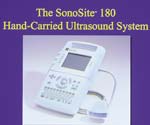 SonoSite 180 (Sonosite Inc.)
SonoSite 180 (Sonosite Inc.)
The product consists of a display unit that houses the system electronics and user interface and a transducer that transmits and receives acoustic energy. Its controls enable the physician to easily optimize images, change the depth of scanning, freeze images, or review recent images. The device can be operated on battery power for up to four hours, with external connections provided for power, video, printer control, and digital data.
Says another MDEA juror, "It changes what has been a fairly formal, relatively expensive, logistically challenging procedure, and reduces it to a procedure no more complex than taking a patient's temperature." Jens Quistgaard, SonoSite vice president of product development, summarizes the benefits of the product's compact design: "Instead of 250- to 500-lb ultrasound systems that are essentially stationary in a lab, having high-quality imaging at the point of care brings a new dimension to medicine and can really improve care."
Portable Cardiac Imaging. Cardiologists need a portable ultrasound system to obtain real-time images of the heart in certain critical-care and emergency situations, as well as for use in remote clinics and rural areas. The Cypress portable ultrasound system for cardiac imaging from Acuson Corp. (Plymouth Meeting, PA) provides effective ultrasound cardiac imaging in a unit that weighs less than 20 lb.
 Cypress portable ultrasound system (Acuson Corp.)
Cypress portable ultrasound system (Acuson Corp.)
According to the manufacturer, the device is the smallest phased-array system ever built and provides all of the capabilities of units that weigh more than 400 lb. Harmonic mode is a standard feature, built-in connectivity allows for networking of images, and an on-board modem permits users to send studies via e-mail. As many as 75 complete examinations can be stored internally on the device's integrated magneto-optical disk.
Because the device is meant to be used in highly mobile applications, it is designed to withstand the rigors of constant transportation. Its internal system interconnects are minimized, key components are shock mounted, and the entire system is built into a unitized metal chassis. The keyboard folds up and the system fits into a small travel case so that it can be placed, for example, on the seat of a car.
Dan Doorley, president of Edge Product Development Corp. (Newtown, PA), who handled the industrial design for Acuson, explains the strategy behind the development of the device: "The idea was to have the unit perform many of the critical functions of larger machines—matching them in performance, though not in total capability—in a package and at a price point that would permit more machines to be purchased for in-field use. As a trend, this market view is shared by our other medical diagnostic clients, in that field deployment of relatively inexpensive systems that are easy to use and provide limited but high-performance testing can offset the escalating cost of medical diagnostic care."
The foundation of the MDEA program is the selection of jurors capable of recognizing the critical role of design and engineering in the development of successful medical products. The MDEA 2000 panel of jurors represents a broad spectrum of disciplines, including medical device manufacturing, industrial design, human factors, engineering, medicine, nursing, product research and development, and academia. The jurors evaluated submissions on the basis of aesthetics, form, and function; end-user benefits to patients and healthcare professionals; technological advancement and innovation; and design factors that facilitate production while reducing overall costs. The nine-member jury panel included: Douglas Anderson has more than 25 years of experience in high-technology product development. After receiving his qualification in industrial design engineering from Napier University in Edinburgh, Scotland, Anderson worked at a number of design firms prior to founding Crombie Anderson Associates Ltd. in 1981, where he is currently chairman. Anderson is also CEO of Optos plc, headquartered in Dunfermline, Scotland, with a North American office in Marlborough, MA. Donald S. Barcan is president of Donbar Industries Inc., a Long Valley, NJ–based package engineering consulting firm specializing in complete sterile package design services. Prior to forming Donbar in 1983, Barcan held packaging engineering positions with several medical product companies, including C. R. Bard and Becton Dickinson. He is a member of the Institute of Packaging Professionals, the American Society for Quality, and the Association for the Advancement of Medical Instrumentation. He holds a BSME degree from Lehigh University and an MBA from Seton Hall University. Joseph F. Dyro, PhD, is president of the Biomedical Resource Group (Setauket, NY), an engineering consultancy. He is a professor of biomedical engineering at Touro College in Dix Hills, NY, and an associate professor of anesthesiology at the State University of New York (SUNY) at Stony Brook. Dyro holds a BS degree in electrical engineering from the Massachusetts Institute of Technology, and MS and PhD degrees in biomedical electronics engineering from the University of Pennsylvania. Craig M. Jackson, PhD, is an independent consultant in medical diagnostics research and development. Prior to forming his San Diego–based consulting practice, Jackson served as president and director of research and development for Reagents Applications Inc., and as scientific director for the Blood Services Division of the American Red Cross. He was previously an adjunct professor of biochemistry, a professor of biological chemistry, and an associate professor of internal medicine at Detroit's Wayne State University School of Medicine. He has also been a visiting professor at Kyushu University in Japan. Jackson received a BS degree from Washington State University and a PhD from the University of Washington. Corinna E. Lathan, PhD, is president and CEO of AnthroTronix Inc. (College Park, MD). She is a consultant to the National Rehabilitation Hospital's Assistive Technology Research Center, a principal investigator at the Home Care and Telerehabilitation Technologies Center of the Catholic University of America, and an adjunct assistant professor of imaging science and information systems at Georgetown University's Medical School. She is currently chair of NASA's operational space telemedicine advisory panel. She holds an MS degree in biopsychology and mathematics from Swarthmore College, and MA (aeronautics and astronautics; biomedical division) and PhD (neuroscience) degrees from the Massachusetts Institute of Technology. Eliot S. Lazar, PhD, is the principal of elCON Medical, a Buffalo, NY–based consultancy. He is an ophthalmologist specializing in anterior segment pathology and surgery, and has several university appointments. Lazar has a BA degree from the University of Pennsylvania, an MS from the State University of New York at Buffalo, and an MD from Georgetown University. Tom Marsh is an operating room nurse at Kaiser Permanente's Hospital in Woodlands Hills, CA. He previously held a similar position at Kaiser's Panorama City, CA, hospital, and was an operating room technician at Verdugo Hills Hospital in Glendale, CA. He received BS and MS degrees in health administration from California State University, Northridge. Herbert F. Voigt, PhD, the current president of the Biomedical Engineering Society (BMES), has been elected to the College of Fellows of the American Institute of Medical and Biological Engineers (AIMBE). He is both the associate chairman for undergraduate affairs and an associate professor at Boston University's Department of Biomedical Engineering. He is also an associate research professor in the Department of Otolaryngology. He received a BS degree in electrical engineering from the City College of New York, and a PhD in biomedical engineering from Johns Hopkins University. Michael E. Wiklund, the chair of the MDEA 2000 jury panel, is the director and principal research scientist of the New England Research Center of the American Institutes for Research. He is an adjunct associate professor in the engineering psychology program of the Department of Mechanical Engineering at Tufts University. Wiklund is also a member of the Human Factors and Ergonomics Society, the Association for Computing Machinery, and the Association for the Advancement of Medical Instrumentation. Holding BS (civil engineering) and MS (human factors) degrees from Tufts University, Wiklund is also a professional engineer. |
Enhancing Image Quality and Ultrasound Productivity. The need for better-quality images, higher productivity, and expanded applications is a constant concern in the ultrasound field. The Logiq 700 Expert Series ultrasound system from GE Medical Systems (Milwaukee) represents significant improvement in several aspects of ultrasound capability.
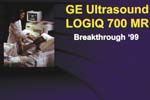 Logiq 700 Expert Series ultrasound system (GE Medical Systems)
Logiq 700 Expert Series ultrasound system (GE Medical Systems)
With an all-digital design, the Logiq 700 provides clear imaging and image transportation using networking technology.
While ultrasound systems traditionally produce a 2-D image of the anatomy, the Logiq 700 can acquire 3-D images. To capture 3-D images, the sonographer slides a handheld transducer across the body perpendicular to the 2-D plane being scanned. The system acquires 2-D image slices and stacks them, automatically calculating the distance between slices. Using 3-D views of the anatomy, radiologists can enhance surgical planning and diagnosis.
The device also offers an improved lens. Instead of the typical ultrasound lens made of a one-dimensional array of 128 small, individually controlled, piezoelectric crystals, the lens of this device is a two-dimensional array of 1024 crystals, representing a 50% improvement in image quality.
Increased productivity and reduction of repetitive motion injuries for operators were additional design goals for the Logiq 700. To reduce operator keystrokes by half, engineers videotaped and observed thousands of hours of ultrasound scanning. From this research, they developed autooptimization of image quality.
According to Brian McEathron, program manager for leadership ultrasound at GE Medical Systems, "The trends are consistent for ultrasound. Better image quality allows a more confident diagnosis. To achieve the productivity that enables hospitals and clinics to be cost-effective requires systems that are easy to use and learn and fast at identifying disease states."
REHABILITATION AND ASSISTIVE-TECHNOLOGY PRODUCTS
Hearing Assistance at the Speed of Sound. Hearing aids must be small and comfortable, yet provide quality that is as close as possible to natural hearing. The Natura Digital Hearing Device from Sonic Innovations (Salt Lake City; gold award winner) contains a tiny chip that processes sound 50 to 90% faster than a traditional hearing aid. According to one juror, "The innovation is in patient comfort and acceptance of the underlying technology, as well as in the product interface." Another juror adds that "the company has looked at a variety of different things—for example, patient acceptance. The fact that it is used totally within the ear canal is going to lead to huge acceptance of this device."
 Natura Digital Hearing Device (Sonic Innovations)
Natura Digital Hearing Device (Sonic Innovations)
The shell of the device is customized to fit the ear canal of each patient. Audiologists use PalmPilots supplied by Sonic Innovations to record the hearing settings of each patient and relay that information to the manufacturer so that each device can be custom calibrated.
Because the chip is so tiny, the device is nearly invisible when worn in the ear, but it can break down sound into more than twice as many distinct channels as other hearing aids. With nine distinct frequency bands, the device can be adjusted to the individual user's type and degree of hearing loss.
Orlando Rodrigues, vice president of marketing at Sonic Innovations, notes that "Consumers really warmed up to the natural, lifelike signal processing that the Natura provided. We were able to get to a level of consumer satisfaction that was higher than what had been previously offered in the field."
Remote Monitoring of Vital Signs. For long-term care, regular monitoring of vital signs such as weight, blood pressure, pulse, and heart rhythm is essential. Monitoring gives the patient and provider the information they need to make behavioral modification decisions, such as diet and exercise changes, and treatment decisions, such as medication usage.
The Interactive Healthcare Service from Agilent Technologies (Palo Alto, CA) electronically connects patients and their physicians, promoting improved disease management and fewer hospitalizations. Patients using the service receive a set of portable, easy-to-use devices that require only minutes a day to measure and transmit vital signs. The patients use the measurement devices at home as part of their daily routine, and data are automatically transferred to the health provider's computer system.
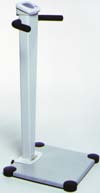 Interactive Healthcare Service device (Agilent Technologies)
Interactive Healthcare Service device (Agilent Technologies)
"Certainly the greatest industry trend we are addressing is the movement of care out of the hospital and into patients' homes," says Jim Reuter, Agilent's research and development project manager. "Patients are becoming more actively involved in their care and are better educated about their particular condition."
The devices include a scale, a blood-pressure unit, and a rhythm strip recorder for monitoring heart rhythm. They are designed for use by patients who may have reduced mobility; for example, the scale has supports for getting on and off as well as an elevated display for easy reading.
According to the manufacturer, patients using this service had an average hospital readmission rate of 0.21 visits per year compared with an average rate of 1.9 per year for those not using the service. Emergency room visits for users of the system were cut by one-third and home nursing visits dramatically decreased.
Remote Communication with Patients. Another solution to the need for communication with home-bound patients is the Health Hero Network Health Buddy system for collecting and transmitting patient data. Manufactured by Health Hero Network Inc. (Mountain View, CA), this product improves the quality of long-term care by using the Internet to allow physicians to monitor their patients.
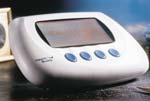 Health Buddy system (Health Hero Network Inc.)
Health Buddy system (Health Hero Network Inc.)
The Health Buddy system combines a tabletop device on which patients report health information with a patient database that physicians access using a Web browser. The patient system comprises a backlit LCD screen, a built-in modem, a simple screen interface, and a built-in serial port for connecting monitoring devices such as glucose meters, weight scales, and blood-pressure meters. At periodic intervals, the system asks the patients a series of questions about their medication, state of well-being, and eating habits, and then sends the information to a service center for evaluation.
The initial target population for the Health Buddy includes patients with heart failure, Parkinson's disease, diabetes, and advanced-stage renal failure.
Preventing Amputations. For patients with diabetic foot ulcers, the prognosis is often years of progressive amputations, a process known as "whittling." By increasing the circulation in the foot, many of these amputations can be prevented.
There are a number of medical devices that apply cyclic pressure to the extremities. Many are inefficient in operation, generating more air pressure than necessary. This can cause the devices to leak at needlessly high pressures, require excessive repairs, exhibit shortened compressor life, and produce high noise levels, which can contribute to patient noncompliance.
The NuPulse mechanical compression device from Kinetic Concepts Inc. (KCI; San Antonio, TX) increases the blood flow to the foot so that oxygen- and nutrient-rich blood can reach an ulcer site. According to the manufacturer, in 75% of all cases treated with NuPulse, amputations were rendered unnecessary.
 NuPulse mechanical compression device (Kinetic Concepts Inc.)
NuPulse mechanical compression device (Kinetic Concepts Inc.)
The device is designed to be highly efficient because its compressor unit is specifically adapted for therapeutic applications of cyclic pressures. It contains no cooling fan and is therefore quieter and less intrusive than other such devices. With a large handle for transport plus a single lighted, oversized on/off switch and a universal foot wrap for either foot, the device is designed for easy home use.
"Prophylaxis is not all that popular in general," notes KCI director of research and development Dave Tumey. He points out that one of the biggest challenges for bringing this product to market is convincing people in the medical community to spend money on a therapy that is preventive in nature, even though the "cure"—successive amputations—is obviously undesirable for the patient. "It's hard to convince people that by spending a little money now they will save much more than money later."
SURGICAL EQUIPMENT, INSTRUMENTS, AND SUPPLIES
Reduced Time for Endoscopy. In endoscopic surgery, the time required for applying traditional metal ligating clips can be significant. These clips can also become easily dislodged from vessels and cause bleeding or potential vessel damage.
The Weck Hem-o-lok polymer ligation clip system from Weck Closure Systems (Research Triangle Park, NC; gold award winner) is designed with locking features that improve the surgeon's speed while lowering the risk of damage to vessels.
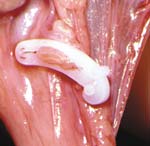 Weck Hem-o-lok (Weck Closure Systems)
Weck Hem-o-lok (Weck Closure Systems)
Jurors commented that the device design succeeded in approaching a potentially complex procedure with a relatively simple solution. Says juror Joseph Dyro, "It looks like the kind of product that would be fraught with opportunities for people to have mishandling errors—dropping clips, for instance. Perhaps the most outstanding aspect of the product is that it seems, every step of the way, that the design has taken something that appears impossibly difficult, and does it easily."
Each v-shaped clip is designed with two opposing curved legs, one concave and the other convex. At each end of the clip legs, there are sharp, pointed teeth; a single tooth at the end of the convex clip leg passes through two teeth on the opposing concave leg. These features facilitate tissue penetration during clip closure and allow the clip to engage and lock when closed. Along the inside surface of each clip are teeth that grip the vessel when the clip is closed to prevent clip slippage. The opposing teeth on each end of the clip legs align the legs during closure and prevent scissoring. The clips are designed with a circular boss on each end to securely engage with the jaws of an applier. These mating features between clip and applier further prevent clip slippage.
Tim Appleby, a project leader at Weck, states that the clip "demonstrates a technological trend of improving surgical efficiency and speed. The product's intended function is to provide the same ligation characteristics as sutures, but with the added advantage of allowing surgeons to ligate tissues and vessel structures at a much faster rate." Says Appleby, "This trend will remain vitally important for medical device manufacturers as long as there are concerns for surgical procedure time and patient costs."
Internal Packing without Bacterial Growth. Typically, PVA packing is left in the body for up to a week to facilitate healing; however, the packing provides a moist environment that encourages the growth of microorganisms, which can cause postoperative problems, such as odor or infection.
The Saufera bacteriostatic PVA foam sponge from Hydrofera LLC (Willimantic, CT) contains a cocktail of two organic dyes that will prevent the growth of microorganisms for up to seven days of use. The sponge can be compressed to one-tenth of its hydrated size and is optimally employed to control bleeding in tight body passages after nasal and sinus surgery or for orthopedic and gynecological procedures.
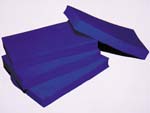 Saufera Bacteriostatic Sponge (Hydrofera LLC)
Saufera Bacteriostatic Sponge (Hydrofera LLC)
Active against staphylococcus aureus and other odor-causing bacteria, the sponge continues to function in the presence of blood, which renders some germicides ineffective. The product is extremely soft when wet for easy removal and insertion.
You May Also Like

.png?width=300&auto=webp&quality=80&disable=upscale)
